Ijraset Journal For Research in Applied Science and Engineering Technology
- Home / Ijraset
- On This Page
- Abstract
- Introduction
- Conclusion
- References
- Copyright
Design and Fabrication of Paper Counting Machine
Authors: Ashokkumar R, Barathan S, Suresh R, Sivapriya S, Kavinkumar N
DOI Link: https://doi.org/10.22214/ijraset.2022.41169
Certificate: View Certificate
Abstract
For counting of papers in academic institutions and industries, there are no feasible machines available. The design is mainly focused on cost effectiveness and for light to medium usages. The machine is constructed by using rollers, battery, DC motor, LED display, Arduino and IR sensor. In this machine initially we need to keep bunch of papers in the paper feeding tray, then the Arduino is reset. The LED displays the number of papers counted. The machine works based on IR sensor & colour detection. The machine is designed for counting the standard A4 size paper. The roller helps in separating each sheet from a bunch of sheets.
Introduction
I. INTRODUCTION
For counting of papers in academic institutions or in industries or wherever the usage of papers & documentation is high, there are no feasible machines or devices available for saving valuable time. The manual counting may result some error and costs time. Maintaining of databases in documentation area is difficult. Some of the available machines are high in cost and suitable mainly for heavy usages. The available machines also involve complex mechanisms. So that it is proposed to design a cost effective simple paper counting machine using simple mechanical & electronics systems. The design is mainly focused on cost effectiveness and for light to medium usages. It is also suitable for multiple usages and applications. The introduced machine should be portable, effective, efficient and it should adopt to innovations to be made in future. A market survey states that major problem faced by reprographies, stationary shops, documentation sectors are counting and collecting of papers. An average of 1 to 50 papers become a easy task whereas more than 50 becomes a challenging one. So, the introduced machine will be more feasible for their problem.
II. SELECTION OF COMPONENTS
A. Acrylic sheets
The medium impact acrylic sheet is selected as a base material of the machine. The vertical plates and bottom plate are made using sheets of thickness 10 mm. The Electronic unit cover, Top cover are made using thickness of 4 mm. The material is easily available in variety of colors, thickness and transparency which is also compact in weight and effective in cost.
B. Frame
The Frame used is easily available aluminium frame with a square section of 30 X 30 mm. The frame is chosen as it is most feasible for mechanical mountings, light weight and low cost. The frame part joins the bottom and vertical plates, collecting and feeding tray.
C. Sheetmetal
The Collecting tray and feeding tray of this machine is made using sheetmetal. The glass fibre may be effective in some cases as surface finish is helpful for smooth flow of papers. But, as the machine is cost effective and easily portable, the best choice is sheetmetal. The sheetmetal used has a thickness of 1.5 mm.
D. Arduino
The Electronic controller used in the machine is Arduino UNO R3 board. The board acts as a controller which controls the DC Motor and IR Sensor. The inputs such as IR signals and outputs such as Motor control and LED Display count are processed in this board. The board is feasible in cost and the electronic connections are easy.
E. DC Motor
Three DC Motors controls the feeding, flowing and collecting of papers. The motors are connected with the Arduino with the help of drivers. The motors consumes low power and provides enough torque. The motors used are 12 V DC with a speed of 150 RPM.
F. Motor Driver
The electronic power voltage fluctuation may burn out the Arduino. So, to overcome this effect and to provide better electronic connection, a motor driver module is used here. In this machine, the module used is L293D chipset. There are two Motor driver modules used here.
G. IR Sensor
The main objective of the machine which is counting is obtained by the use of Infrared (IR) Sensor. The sensor is very low in cost. It is easily connectable with the Arduino and high efficiency in object detection.
H. LED Display
The outcome of this machine is recorded by the use of 8 segment LED Display connected with the Arduino.
I. Belt Drive
As the End part of the flowing process of papers requires more precise separation so that the detection and counting process becomes more efficient. The end part which has two rollers rotating in opposite directions is connected through a belt driven pulleys. The belt is Rubber made.
J. Rollers
There are three different sized rollers in this machine which acts as a mechanism for separation and smooth flow of papers. The Rollers are Connected with the motors through Shafts and bearings. The rollers are made up of ABS Plastic as it is very light weight and has smooth surface finish which does not do damages for the paper.
K. Bearings
The bearings ensure the smooth rotation of the shafts in this machine. This also mounts the shafts and motors with the vertical plates of the machine. Two different sized bearings are used with Inner diameter of 10, 6 mm and outer diameter of 30,19 mm respectively.
III. MECHANISMS AND METHODOLOGY
The machine works on the basic objective which is obtained by the use of two processes explained below.
A. Counting Mechanism
The Papers are initially fed on the feeding tray. Then the Machine is Reset and the Papers are flown through the tray and each single sheet is separated and the IR sensor detects the flow and the flow is counted and it is displayed in the LED display.
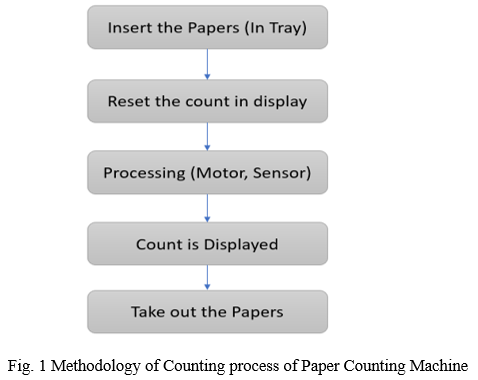
???????B. Collecting Mechanism
The other process is collecting of papers. Initially the paper is fed in the feeding tray and the required number of papers are set with the help of Arduino and the papers will get separated and counted with the above counting procedure. When the set number of papers are collected, the machine will stop.
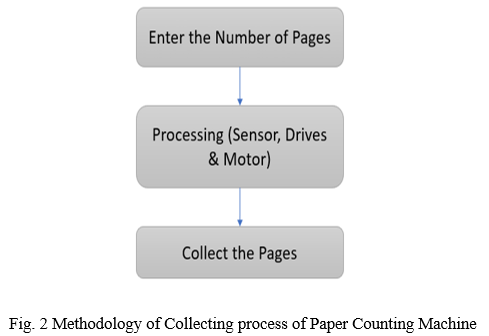
???????C. Working Methodology
The machine consists of mechanical components such as Motors, Rollers, Acrylic sheets, Sheetmetal, Shafts, bearings, nuts, bolts, frames, clamps, screws. And the electronic components are Infrared sensor, Arduino board, breadboard, L293D chipsets, wires, battery and LED display. Initially the paper bundle is fed in the feeding tray of the machine, then after resetting the Arduino the motors starts and the first roller which is a tyre like in both the ends starts pulling the papers and the separation of papers starts here. For more efficiency there is a roller in middle part which is also pulls the paper to the end part. The first and middle roller and controlled by individual motors connected with Arduino with single motor driver. The end part has two rollers because of more requirement of precise separation of paper which is controlled by a single motor and a motor driver. The two rollers rotate in opposite direction which is obtained by using a belt pulley drive. Then the paper is flown and the Infrared sensor detects and the count is displayed in the LED display. The process is repeated.
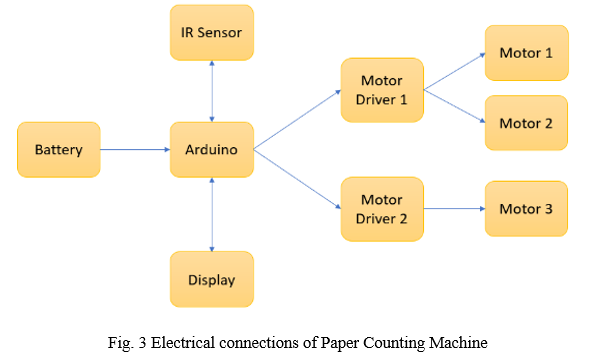
IV. DESIGN
The electronics are connected with the use of breadboard and the electronic mountings are covered by an acrylic transparent cover. The top body of the machine is also covered by transparent acrylic sheet to protect the papers and machine from dusts. The base plate and vertical plates are joined with the use of aluminium frames. The trays are also connected with the plates using aluminium frames. The motors are mounted on the vertical plate with the use of motor clamps. The shafts holds the Rollers and the shafts are mounted with the motors and vertical members through bearings. The IR sensor is mounted in the End part of the machine.
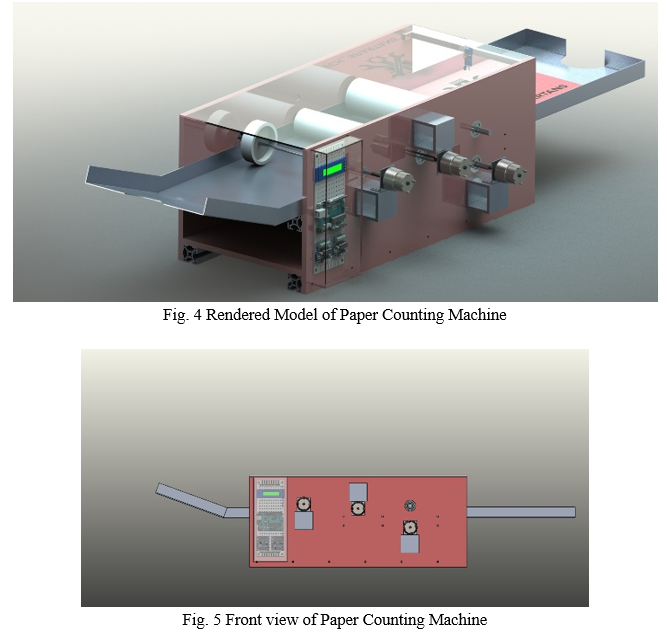
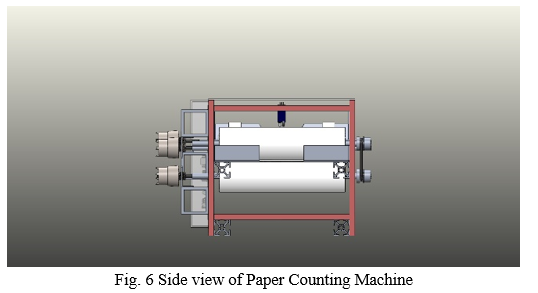
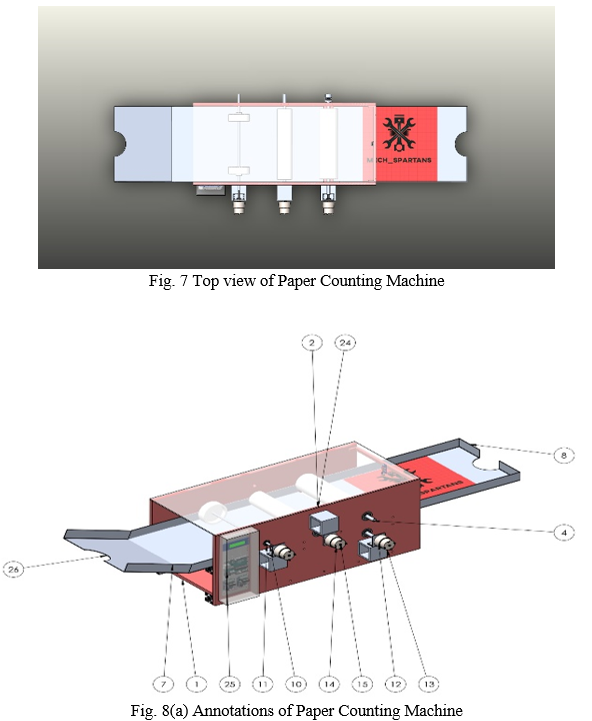
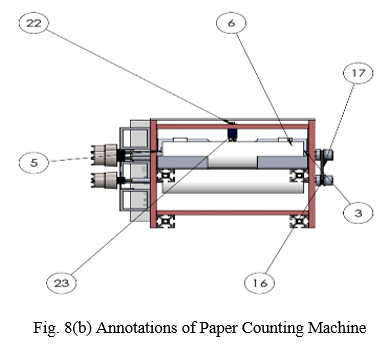
TABLE I
DESIGN SPECIFICATIONS
|
S.no |
Component |
Material |
Specification |
|
1 |
Base plate |
Acrylic sheet |
600 * 250 mm |
|
2 |
Vertical plate |
Acrylic sheet |
600 * 250 mm |
|
3 |
End Roller |
ABS Plastic |
OD = 59.5 mm |
|
4 |
Shaft |
Aluminium |
OD = 10 mm |
|
5 |
Middle Roller |
ABS Plastic |
OD = 48 mm |
|
6 |
Roller tyre |
Rubber |
OD = 69 mm |
|
7 |
Frame |
Aluminium |
30 * 30 mm c/s |
|
8 |
Collecting tray |
Sheetmetal |
1.5 mm thick |
|
9 |
Bearing |
Chrome stainless steel |
ID = 10 mm OD = 30 mm |
|
10 |
Shaft |
Aluminium |
OD = 6 mm |
|
11 |
Bearing |
Chrome stainless steel |
ID = 6 mm OD = 19 mm |
|
12 |
Motor clamp |
Aluminium |
3 Nos |
|
13 |
Motor Support |
Aluminium |
3 Nos |
|
14 |
Motor |
- |
12 V DC, 150 RPM |
|
15 |
Motor shaft |
- |
- |
|
16 |
Pulley |
Aluminium |
2 Nos |
|
17 |
Belt |
Rubber |
Length = 168.69 mm |
|
18 |
Arduino |
- |
Arduino UNO R3, 5 V |
|
19 |
Motor Driver Module |
- |
L293D |
|
20 |
LED Display |
- |
LED 12864 |
|
21 |
Breadboard |
- |
830 tie points |
|
22 |
IR Card |
Acrylic sheet |
- |
|
23 |
IR Sensor |
- |
- |
|
24 |
Top cover |
Acrylic sheet |
- |
|
25 |
Electronics cover |
Acrylic sheet |
- |
|
26 |
Feeding tray |
Sheetmetal |
1.5 mm thick |
V. STATIC STUDY
The important mechanical parts which forms the Machine’s structure were to be studied so that the conclusion can be made whether the dimensions, material, design, DFMA etc., are safe and in limit so that the machine will work fine and no errors takes place. The importance of static study is to design a machine safer to avoid vibrations, thermal effects, stresses and strains etc., The said parameters are studied and analysed using Solidworks software by performing static study. The mechanical specifications and parameters for the materials are shown in below table.
TABLE III
Material SPECIFICATIONS
|
S.no |
Parameter |
Acrylic sheet |
Aluminium |
|
1 |
Name |
Acrylic (Medium-high impact) |
1060 Alloy |
|
2 |
Type |
Linear Elastic Isotropic |
Linear Elastic Isotropic |
|
3 |
Yield strength |
4.5e7 N/m2 |
2.75742e7 N/m2
|
|
4 |
Tensile strength |
7.3e7 N/m2 |
6.89356e7 N/m2
|
|
5 |
Elastic modulus |
3e9 N/m2 |
6.9e10 N/m2
|
|
6 |
Poisson’s ratio |
0.35 |
0.33 |
|
7 |
Density |
1,200 kg/m3 |
2,700 kg/m3 |
|
8 |
Shear modulus |
8.9e8 N/m2 |
2.7e10 N/m2 |
|
9 |
Thermal expansion |
5.2e-5 /Kelvin |
2.4e-5 /Kelvin |
???????A. Base Plate
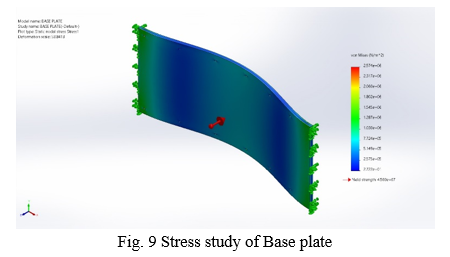
The part is made up of Acrylic sheet material. The total mass of the part is identified as 1.79771 kg. No thermal effects takes place in this part. The Von mises stress is found to be a minimum of 2.722e1 N/m2 and a maximum of 2.574e6 N/m2. As the stress is found to be in limit and in safe zone, the design is safe.
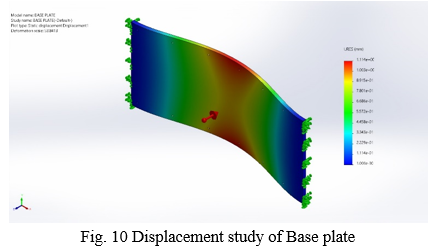
The URES Resultant displacement is found to be a minimum of 0 and a maximum of 1.114e0 mm. As the displacement is found to be in limit and in safe zone, the design is safe.
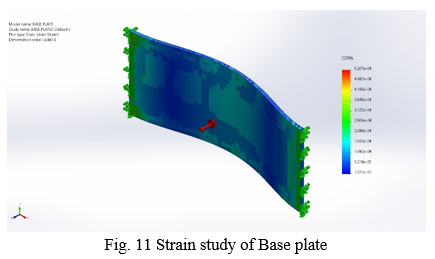
The Equivalent strain is found to be a minimum of 1.221e-7 and a maximum of 5.207e-4. As the strain is found to be in limit and in safe zone, the design is safe.
???????B Vertical Plate

The part is made up of Acrylic sheet material. The total mass of the part is identified as 1.76527 kg. No thermal effects takes place in this part. The Von mises stress is found to be a minimum of 0 and a maximum of 3.407e-4 N/m2. As the stress is found to be in limit and in safe zone, the design is safe.
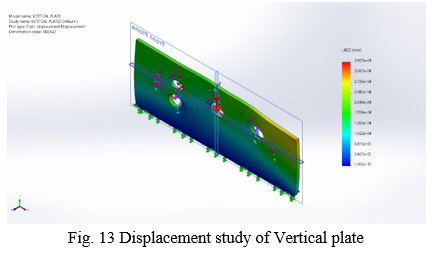
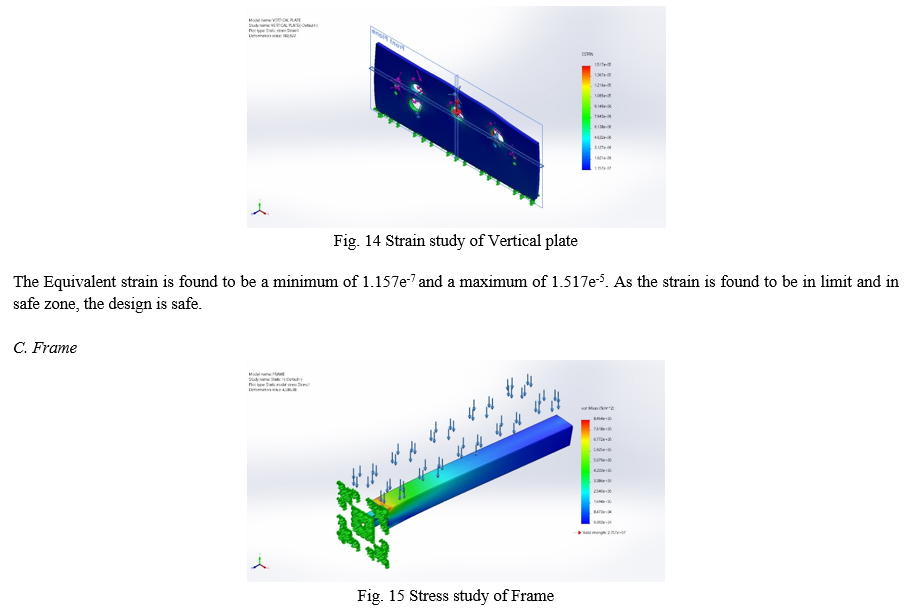
The part is made up of Aluminium material. The total mass of the part is identified as 0.027 kg. No thermal effects takes place in this part. The Von mises stress is found to be a minimum of 9.393e1 N/m2 and a maximum of 8.4645 N/m2. As the stress is found to be in limit and in safe zone, the design is safe.
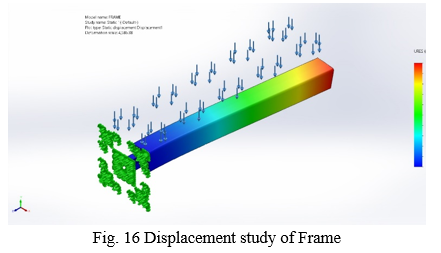
The URES Resultant displacement is found to be a minimum of 0 and a maximum of 2.641e-3 mm. As the displacement is found to be in limit and in safe zone, the design is safe.
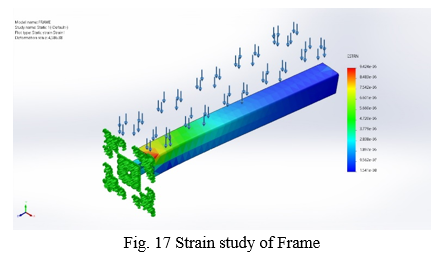
The Equivalent strain is found to be a minimum of 3.051e-9 and a maximum of 9.424e-6. As the strain is found to be in limit and in safe zone, the design is safe.
VI. RESULTS AND DISCUSSION
The machine is designed and fabricated with simple mechanical and electronic systems at very low cost. This machine is portable and affordable. The machine is mainly suitable for low to medium usages in offices, accounts section, stationery shops, Reprographies etc., This machine is also maintenance free. It also occupies less space only. Setting the allowance between the roller and the tray is the difficult task, as it leads to improper separation of papers.
Conclusion
The output expected in this machine is to reduce the human power and the time taken to count the papers in industries and in educational institutes and it is achieved. Further improvements like increasing the capacity of papers in the tray can be made by incorporating additional rollers. This machine can be used for further applications like counting cards by incorporating additional features. The machine can be also further automated by using additional electronic and mechanical systems.
References
[1] Irshath Ahamed R, Mohamed Amir, Kamalnathan P,Kalaiselvan, Automatic paper vending machine, International Journal of Science, Engineering and Technology Research (IJSETR), Volume 4, Issue 4, April 2015. [2] Li Y Tang, Y Zhang, & Liu N, Study on Paper Separating Mechanism of Counting Machine. In Applied Mechanics and Materials (Vol. 312, pp. 226-230). Trans Tech Publications Ltd. [3] Anju S, Chippy SR, Haritha H, Nijo VC. and Er. Beena A.O., Automatic Paper Counting Machine, International Journal of Science Technology & Engineering (IJSTE) Vol.2, Issue 10, pp.917-921, 2016. [4] Faculty of Mechanical Engineering: Design Data. 4th edn. Kalaikathir Achchagam, Coimbatore (2017).
Copyright
Copyright © 2022 Ashokkumar R, Barathan S, Suresh R, Sivapriya S, Kavinkumar N. This is an open access article distributed under the Creative Commons Attribution License, which permits unrestricted use, distribution, and reproduction in any medium, provided the original work is properly cited.

Download Paper
Paper Id : IJRASET41169
Publish Date : 2022-04-01
ISSN : 2321-9653
Publisher Name : IJRASET
DOI Link : Click Here
 Submit Paper Online
Submit Paper Online

